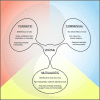An Ecological Framework of the Human Virome Provides Classification of Current Knowledge and Identifies Areas of Forthcoming Discovery
- PMID: 27698618
- PMCID: PMC5045143
An Ecological Framework of the Human Virome Provides Classification of Current Knowledge and Identifies Areas of Forthcoming Discovery
Abstract
Recent advances in sequencing technologies have opened the door for the classification of the human virome. While taxonomic classification can be applied to the viruses identified in such studies, this gives no information as to the type of interaction the virus has with the host. As follow-up studies are performed to address these questions, the description of these virus-host interactions would be greatly enriched by applying a standard set of definitions that typify them. This paper describes a framework with which all members of the human virome can be classified based on principles of ecology. The scaffold not only enables categorization of the human virome, but can also inform research aimed at identifying novel virus-host interactions.
Keywords: commensalism; ecology; endogenous retroelements; evolution; human health; immunology; microbiology; microbiome; mutualism; parasitism; phage therapy; symbiosis; virology; virome.
Figures

Similar articles
-
[These viruses that inhabit and visit us: The human virome].Med Sci (Paris). 2022 Dec;38(12):1028-1038. doi: 10.1051/medsci/2022161. Epub 2022 Dec 13. Med Sci (Paris). 2022. PMID: 36692282 Review. French.
-
The healthy human virome: from virus-host symbiosis to disease.Curr Opin Virol. 2021 Apr;47:86-94. doi: 10.1016/j.coviro.2021.02.002. Epub 2021 Feb 27. Curr Opin Virol. 2021. PMID: 33652230 Review.
-
Elimination of Foreign Sequences in Eukaryotic Viral Reference Genomes Improves the Accuracy of Virome Analysis.mSystems. 2022 Dec 20;7(6):e0090722. doi: 10.1128/msystems.00907-22. Epub 2022 Oct 26. mSystems. 2022. PMID: 36286492 Free PMC article.
-
VirusSeeker, a computational pipeline for virus discovery and virome composition analysis.Virology. 2017 Mar;503:21-30. doi: 10.1016/j.virol.2017.01.005. Epub 2017 Jan 18. Virology. 2017. PMID: 28110145 Free PMC article.
-
Virome genomics: a tool for defining the human virome.Curr Opin Microbiol. 2013 Aug;16(4):479-84. doi: 10.1016/j.mib.2013.04.006. Epub 2013 May 23. Curr Opin Microbiol. 2013. PMID: 23706900 Free PMC article. Review.
Cited by
-
Prevalence of Epstein-Barr virus, human papillomavirus, cytomegalovirus and herpes simplex virus type 1 in patients with diabetes mellitus type 2 in south-eastern Poland.PLoS One. 2019 Sep 24;14(9):e0222607. doi: 10.1371/journal.pone.0222607. eCollection 2019. PLoS One. 2019. PMID: 31550259 Free PMC article.
-
Glutathione peroxidase (GPx) and superoxide dismutase (SOD) activity in patients with diabetes mellitus type 2 infected with Epstein-Barr virus.PLoS One. 2020 Mar 25;15(3):e0230374. doi: 10.1371/journal.pone.0230374. eCollection 2020. PLoS One. 2020. PMID: 32210468 Free PMC article.
-
The temporal RNA virome patterns of a lesser dawn bat (Eonycteris spelaea) colony revealed by deep sequencing.Virus Evol. 2020 Mar 18;6(1):veaa017. doi: 10.1093/ve/veaa017. eCollection 2020 Jan. Virus Evol. 2020. PMID: 33747541 Free PMC article.
-
The Human Virome: Implications for Clinical Practice in Transplantation Medicine.J Clin Microbiol. 2017 Oct;55(10):2884-2893. doi: 10.1128/JCM.00489-17. Epub 2017 Jul 19. J Clin Microbiol. 2017. PMID: 28724557 Free PMC article. Review.
-
Retroviruses of the Human Virobiota: The Recycling of Viral Genes and the Resulting Advantages for Human Hosts During Evolution.Front Microbiol. 2020 May 28;11:1140. doi: 10.3389/fmicb.2020.01140. eCollection 2020. Front Microbiol. 2020. PMID: 32547531 Free PMC article. Review.
References
-
- Whipps JM, In: Fungi Biol Control Syst. Burge N, editor. Manchester: Manchester University Press; 1988. Mycoparasitism and plant disease control. pp. 161–187.
-
- Lederberg J. ’Ome Sweet 'Omics-- A Genealogical Treasury of Words. Scientist. 2001;15:8.
-
- International Human Genome Sequencing Consortium. Initial sequencing and analysis of the human genome. Nature. 2001;409(6822):860–921. - PubMed
Publication types
MeSH terms
LinkOut - more resources
Full Text Sources
Research Materials
